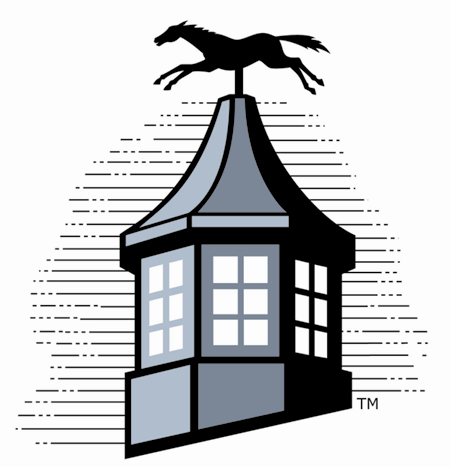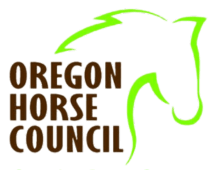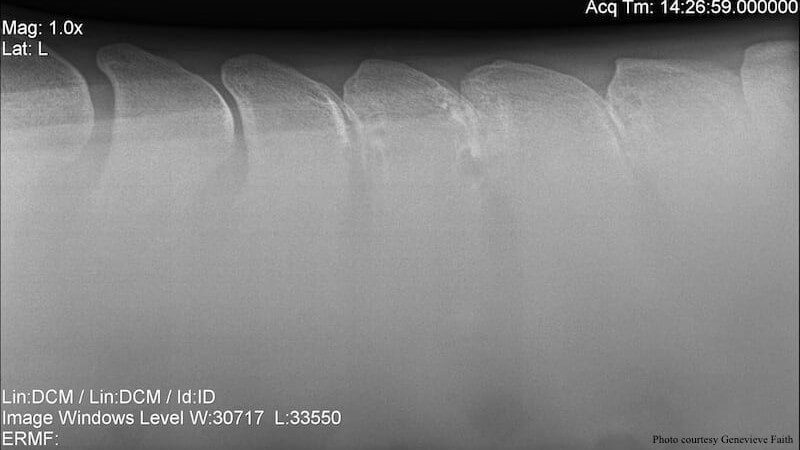Oakhurst Equine’s own Dr. Root was on the cutting edge of this diagnosis and surgery. Multiple members of the Oakhurst Team now perform the surgical procedure that is life changing for most patients with only six weeks between rides! If your horse is exhibiting symptoms, or more traditional treatments have not improved performance as much as you had hoped, contact Oakhurst for a consultation to see if we can help!
The seemingly innocent term “kissing spines” actually refers to a potentially painful, performance limiting condition of the equine back. While kissing spines (impinging spinous processes) may seem like a diagnosis du jour, garnering only intermittent fad-like attention, Sue Dyson, an internationally renowned equine lameness expert, says this back problem occurs quite commonly in young, fit racehorses. In fact, Thoroughbreds have a higher frequency of occurrence of kissing spines than many other breeds.
In a normal spinal column, the individual vertebrae are lined up like a row of ducks. Long, thin bony projections called spinous processes extend upwards from these bony vertebrae (dorsally). Normally, these skyward reaching spinous processes should be physically separated from one another, even during locomotion. In some cases, however, the spinous processes end up crowding one another, gently touching or “kissing.” In severe cases, the spinous processes actually overlap one another.
As one can imagine, having these bony projections compressing on one another can severely limit performance.
“In the racehorse world, there seems to be a lack of awareness of the presence of musculoskeletal pain unless a horse shows overt lameness. In turn, there is a lack of recognition that back pain can compromise performance,” said Dyson.
According to Dyson, back pain may be mistaken for bilateral forelimb or hind limb lameness because it often results in shortened steps without overt lameness. In some cases, back pain is overlooked completely with the horse instead being described as a “scratchy mover.”
“Many racehorses have back pain that goes unrecognized, which may be compounded by a poorly-fitting saddle or a work rider who is not always in balance with the horse at all gaits,” Dyson said.
In fact, poor behavior or behavior changes may be the only obvious “abnormality” appreciated in horses with back pain, but this often goes unrecognized.
Horses with back pain, including those with kissing spines, may manifest their discomfort by:
- Displaying abnormal behavior when tacked up
- Stiffening the back when first mounted
- Dipping (extending) the back when first moving forwards
- Bucking
- Exhibiting an unwillingness to bend or move forward as freely as normal
- Bunny hopping in the canter
- Failing to pick up or hold a specific lead on their canter
“Horses can even show behaviors that are sometimes attributable to the horse’s untoward demeanor rather than as a result of pain,” Dyson explained.
Recognizing that behavior may be a valuable indicator of pain, Dyson developed a pain ethogram to help identify musculoskeletal pain in horses. This ethogram uses a set of 24 well-described and named behaviors that Dyson identified much more frequently in lame/painful horses compared with sound horses.
Those behaviors were subsequently categorized by Dyson based on the type of behavior, such as facial, body, or gait markers.
For example, facial markers suggestive of musculoskeletal pain included head tilting, rotating ears back behind vertical or lying flat for >5 seconds, closing eyelids for two to five seconds, and repeatedly exposing the sclera. Body markers included clamping the tail tightly and tail swishing, and gait markers were rushed gaits and spontaneous changes in gait.
To use this pain ethogram in real life, one or more evaluators observe the horse move during their typical work and specific exercises (i.e., straight lines, circles, and transitions in walk, trot, and canter under saddle). If the horse exhibits any of the 24 behaviors included in the ethogram, those behaviors are recorded.
“When this ethogram was validated in sport horses, the presence of eight or more of the 24 behaviors was highly likely to reflect the presence of musculoskeletal pain,” said Dyson.

While originally described by Dyson as a ridden horse pain ethogram (RHpE), she that research shows this RHpE can be used to help detect any form of musculoskeletal pain, including primary back pain associated with impinging spinous processes.
“I have not specifically tested the RHpE in racing Thoroughbreds, but I would be surprised if, with some modifications, it was not helpful,” she added.
If a racehorse performs poorly or displays abnormal behavior during ridden exercise, then the back should be examined carefully. The presence of muscle tension and pain or limited range of motion of the back should prompt radiographic assessment.
“Low-grade impinging spinous processes may not be a cause of pain, so infiltration of local anesthetic solution around the close spinous processes is necessary to determine their clinical significance,” Dyson suggested.
In other words, some horses with radiographic evidence of kissing spines may not be experiencing pain at those sites.
In sum, back pain and kissing spines should be considered even in young, apparently healthy Thoroughbred racehorses, especially those with behavior issues, a short-stepping gait or a reluctance to work. Failure to recognize primary back pain may lead to an alteration in gait predisposing to other problems.
Training and racing performance may be improved substantially by successful treatment of impinging spinous processes. Local infiltration of corticosteroids close to the narrowed interspinous spaces, extracorporeal shockwave therapy (ESWT), acupuncture, and mesotherapy are possible treatment options, with surgery as a last resort.
“Any treatment program should be combined with physiotherapy to help to release tight muscles and reduce muscle pain,” she said. “Management changes such as feeding from the ground to encourage back flexion, use of heat lamps or other heating methods prior to exercise, warming-up by walking on a horse walker before ridden exercise, and improving saddle fit will also helpful to try to optimize performance.”
Another factor to consider is that kissing spines may not only affect a racehorses’ training and performance, but also their future careers once they have moved on from the track.
“In my role as a veterinary advisor to a racehorse rehabilitation center, we assess all horses’ backs clinically and radiographically,” said Dyson. “We have had many horses that we have not been able to rehome as riding horses because of chronic back problems relating to severe impinging spinous processes and other secondary problems.”

Oakhurst Thoroughbreds is home to 1996 Kentucky Derby winner GRINDSTONE, Oregon’s famous heritage tree the EWING YOUNG OAK, and a terrific staff and crew! Our Equine Veterinary Services offers full-service equine veterinary care in sports medicine, advanced reproduction and services for stallions and mares, lameness diagnosis and treatment, digital x-ray and ultrasound, prepurchase examinations, general medicine and surgery, podiatry, video endoscopy, equine dentistry, and shock-wave therapy.

